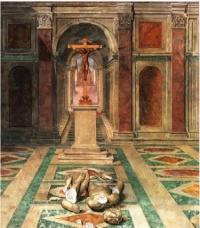Triumph of Christianity
From The Art and Popular Culture Encyclopedia
(Difference between revisions)
| Revision as of 15:19, 7 May 2013 Jahsonic (Talk | contribs) ← Previous diff |
Revision as of 15:22, 7 May 2013 Jahsonic (Talk | contribs) Next diff → |
||
| Line 1: | Line 1: | ||
| [[Image:Tommaso.Laureti.Triumph.of.Christianity.jpg|right|thumb|200px|''[[Triumph of Christianity]]'' by [[Tommaso Laureti]] (1530-1602), ceiling painting in the [[Sala di Constantino]], [[Apostolic Palace|Vatican Palace]]. Images like this one celebrate the destruction of ancient [[Paganism|pagan]] culture and the victory of [[Christianity]].]] | [[Image:Tommaso.Laureti.Triumph.of.Christianity.jpg|right|thumb|200px|''[[Triumph of Christianity]]'' by [[Tommaso Laureti]] (1530-1602), ceiling painting in the [[Sala di Constantino]], [[Apostolic Palace|Vatican Palace]]. Images like this one celebrate the destruction of ancient [[Paganism|pagan]] culture and the victory of [[Christianity]].]] | ||
| {{Template}} | {{Template}} | ||
| - | ''[[Triumph of Christianity]]''[http://www.christusrex.org/www1/stanzas/Ccc-Triumph.jpg] (also known as '''Triumph of the Cross''') is a [[ceiling painting]] in the [[Sala di Constantino]], [[Apostolic Palace]] by [[Tommaso Laureti]] (1530-1602). Images like this celebrate the destruction of ancient [[Paganism|pagan]] culture and the [[victory]] of [[Christianity]]. The painting depicts an ancient statue of the god [[Mercury]] lying broken on the ground. | + | ''[[Triumph of Christianity]]''[http://commons.wikimedia.org/wiki/File:0_Triomphe_du_christianisme_-_Sala_di_Costantino_-_Vatican.JPG] (also known as '''Triumph of the Cross''') is a [[ceiling painting]] in the [[Sala di Constantino]], [[Apostolic Palace]] by [[Tommaso Laureti]] (1530-1602). Images like this celebrate the destruction of ancient [[Paganism|pagan]] culture and the [[victory]] of [[Christianity]]. The painting depicts an ancient statue of the god [[Mercury]] lying broken on the ground. |
| For Christians and secularists alike, the identification of mortal emperors with [[godhead]] represented the spiritual and [[moral bankruptcy]] of paganism which led to the triumph of Christianity as Rome's state religion. | For Christians and secularists alike, the identification of mortal emperors with [[godhead]] represented the spiritual and [[moral bankruptcy]] of paganism which led to the triumph of Christianity as Rome's state religion. | ||
Revision as of 15:22, 7 May 2013

Triumph of Christianity by Tommaso Laureti (1530-1602), ceiling painting in the Sala di Constantino, Vatican Palace. Images like this one celebrate the destruction of ancient pagan culture and the victory of Christianity.
|
Related e |
|
Featured: |
Triumph of Christianity[1] (also known as Triumph of the Cross) is a ceiling painting in the Sala di Constantino, Apostolic Palace by Tommaso Laureti (1530-1602). Images like this celebrate the destruction of ancient pagan culture and the victory of Christianity. The painting depicts an ancient statue of the god Mercury lying broken on the ground.
For Christians and secularists alike, the identification of mortal emperors with godhead represented the spiritual and moral bankruptcy of paganism which led to the triumph of Christianity as Rome's state religion.
See also
- Raphael_Rooms#Sala_di_Costantino
- Christianity and Paganism
- Christianization
- Early Christianity
- History of Christianity
- Triumphalism
Unless indicated otherwise, the text in this article is either based on Wikipedia article "Triumph of Christianity" or another language Wikipedia page thereof used under the terms of the GNU Free Documentation License; or on research by Jahsonic and friends. See Art and Popular Culture's copyright notice.

